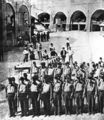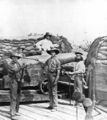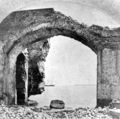Difference between revisions of "Fort McRee"
(→Reuse) |
|||
| Line 17: | Line 17: | ||
The artillery battle continued the next day. In all, Union troops expended 5,000 rounds of ammunition while Confederate troops returned some 1,000 shots. Fort Pickens on the Union side sustained little damage, but Confederate-held Fort McRee, its water battery, as well as the navy yard and the village of [[Warrington]] all sustained extensive damage. Federal troops did sustain two deaths and 13 wounded. Federal artillery inflicted even more damage on [[January 1]] and [[January 2|2]], 1862, causing extensive fire damage at the Navy Yard and exploding the powder magazine at Fort McRee.<ref name="PICW" /> | The artillery battle continued the next day. In all, Union troops expended 5,000 rounds of ammunition while Confederate troops returned some 1,000 shots. Fort Pickens on the Union side sustained little damage, but Confederate-held Fort McRee, its water battery, as well as the navy yard and the village of [[Warrington]] all sustained extensive damage. Federal troops did sustain two deaths and 13 wounded. Federal artillery inflicted even more damage on [[January 1]] and [[January 2|2]], 1862, causing extensive fire damage at the Navy Yard and exploding the powder magazine at Fort McRee.<ref name="PICW" /> | ||
| − | == | + | ==Abandonment, reuse, and decay== |
[[Image:Mcreeruins3.PNG|thumb|right|Remnants of Fort McRee after the [[1906 hurricane]]]] | [[Image:Mcreeruins3.PNG|thumb|right|Remnants of Fort McRee after the [[1906 hurricane]]]] | ||
After the Civil War, Fort McRee was essentially abandoned. This is evidenced by the War Department's permission in 1875 for the commanding officer at [[Fort Barrancas]] to remove 50,000 bricks from McRee to make repairs at Barrancas.<ref name="coleman" /> | After the Civil War, Fort McRee was essentially abandoned. This is evidenced by the War Department's permission in 1875 for the commanding officer at [[Fort Barrancas]] to remove 50,000 bricks from McRee to make repairs at Barrancas.<ref name="coleman" /> | ||
| − | |||
| − | |||
| − | |||
With the completion of the [[Wikipedia:Endicott Board|Endicott Board]] and the subsequent renewed interest in strengthening the coastal defenses of the US, activity returned to Fort McRee. In [[1898]] a battery of two 8-inch rifled guns were constructed just west of the fort, named Battery Slemmer in honor of [[Adam J. Slemmer]]. In [[1899]] a battery of rapid fire guns were installed in another battery named Battery Center after Lieutenant J. P. Center, an officer killed at the [[Wikipedia:Battle of Lake Okeechobee|Battle of Lake Okeechobee]].<ref name="coleman"/> | With the completion of the [[Wikipedia:Endicott Board|Endicott Board]] and the subsequent renewed interest in strengthening the coastal defenses of the US, activity returned to Fort McRee. In [[1898]] a battery of two 8-inch rifled guns were constructed just west of the fort, named Battery Slemmer in honor of [[Adam J. Slemmer]]. In [[1899]] a battery of rapid fire guns were installed in another battery named Battery Center after Lieutenant J. P. Center, an officer killed at the [[Wikipedia:Battle of Lake Okeechobee|Battle of Lake Okeechobee]].<ref name="coleman"/> | ||
Manning of Battery Slemmer and Center were by members of the [[US Coast Guard]]. Manning fluctuated between 50 and 100 personnel who were rotated from Fort Barrancas.<ref name="coleman"/> | Manning of Battery Slemmer and Center were by members of the [[US Coast Guard]]. Manning fluctuated between 50 and 100 personnel who were rotated from Fort Barrancas.<ref name="coleman"/> | ||
| − | + | After the hurricane, only a minimal caretaker staff remained to ensure the security of the site. With America's entry into World War I in 1917, the guns of Battery Slemmer were removed and sent to Europe for mounting on railway cars. In 1920, the guns of Battery Center were declared surplus and removed as well. With the removal of these guns, Fort McRee once again fell into disuse.<ref name="coleman"/> | |
| + | |||
| + | The [[1906 hurricane]] leveled nearly everything that was left of Fort McRee. After the hurricane, only a minimal caretaker staff remained to ensure the security of the site. With America's entry into World War I in 1917, the guns of Battery Slemmer were removed and sent to Europe for mounting on railway cars. In 1920, the guns of Battery Center were declared surplus and removed as well. With the removal of these guns, Fort McRee was once again essentially abandoned.<ref name="coleman"/> | ||
==Other images== | ==Other images== | ||
Revision as of 16:27, 3 May 2009
Fort McRee was a bent elliptical military fort located at the eastern tip of Perdido Key, near Pensacola Pass. Significantly damaged during the Civil War, the fort was essentially abandoned and left to the the elements. There are little or no remnants of the fort visible today.
Contents
Construction
The fort was designed in 1829 by Simon Bernard. Ironically, the man for whom the fort would be named in 1840, Army engineer Colonel William McRee, had resigned his commission in 1819 in protest after Bernard was appointed to a high position in the Army Corps of Engineers.[1]
Construction took place between 1834 and 1839, and as was the case with Pensacola's other area forts, was overseen by William Henry Chase.
Civil War
On January 10, 1861, Florida became the third state to secede from the Union. Shortly thereafter, the commanding Union Army officer in Pensacola, Lieutenant Adam J. Slemmer, decided to abandon Forts Barrancas and McRee and consolidate Union forces at Fort Pickens. Slemmer explained his decision as strategically necessary:
| I called on Commodore [James] Armstrong (Union Commanding Officer of the Navy Yard) ... He had received orders to cooperate with me. We decided that with our limited means of defense we could hold but one fort, and that should be Fort Pickens, as it commanded completely the harbor and the forts and also the navy yard. | ||
—"Pensacola in the Civil War." Florida Historical Quarterly, Vol. IX, No. 2, 1978. | ||
Slemmer's men destroyed over 20,000 pounds of gunpowder at Fort McRee, spiked the guns at Fort Barrancas, and evacuated 51 soldiers and 30 sailors to Fort Pickens.[2] On January 12, rebel troops from Alabama and Florida occupied Fort McRee, as well as the Navy Yard and Fort Barrancas.
At 10:00 AM on the morning of November 22, 1861, the Union batteries at Fort Pickens opened fire on the Confederate steamers docked at the Navy Yard wharf. The steamers escaped the line of fire with minimal damage, but the Confederate guns at Forts McRee and Barrancas returned fire. The Union ships USS Richmond and USS Niagara soon moved closer to shore and joined the Union barrage, firing primarily at Fort McRee. Union guns shot off the flagstaffs at both McRee and Barrancas. Confederate general Braxton Bragg called the artillery battle "grand and sublime," and wrote that "the houses in Pensacola, ten miles off, trembled from the effect; and immense quantities of dead fish floated on the surface of the lagoon, stunned by the concussion."[3]
The artillery battle continued the next day. In all, Union troops expended 5,000 rounds of ammunition while Confederate troops returned some 1,000 shots. Fort Pickens on the Union side sustained little damage, but Confederate-held Fort McRee, its water battery, as well as the navy yard and the village of Warrington all sustained extensive damage. Federal troops did sustain two deaths and 13 wounded. Federal artillery inflicted even more damage on January 1 and 2, 1862, causing extensive fire damage at the Navy Yard and exploding the powder magazine at Fort McRee.[2]
Abandonment, reuse, and decay

After the Civil War, Fort McRee was essentially abandoned. This is evidenced by the War Department's permission in 1875 for the commanding officer at Fort Barrancas to remove 50,000 bricks from McRee to make repairs at Barrancas.[1]
With the completion of the Endicott Board and the subsequent renewed interest in strengthening the coastal defenses of the US, activity returned to Fort McRee. In 1898 a battery of two 8-inch rifled guns were constructed just west of the fort, named Battery Slemmer in honor of Adam J. Slemmer. In 1899 a battery of rapid fire guns were installed in another battery named Battery Center after Lieutenant J. P. Center, an officer killed at the Battle of Lake Okeechobee.[1]
Manning of Battery Slemmer and Center were by members of the US Coast Guard. Manning fluctuated between 50 and 100 personnel who were rotated from Fort Barrancas.[1]
After the hurricane, only a minimal caretaker staff remained to ensure the security of the site. With America's entry into World War I in 1917, the guns of Battery Slemmer were removed and sent to Europe for mounting on railway cars. In 1920, the guns of Battery Center were declared surplus and removed as well. With the removal of these guns, Fort McRee once again fell into disuse.[1]
The 1906 hurricane leveled nearly everything that was left of Fort McRee. After the hurricane, only a minimal caretaker staff remained to ensure the security of the site. With America's entry into World War I in 1917, the guns of Battery Slemmer were removed and sent to Europe for mounting on railway cars. In 1920, the guns of Battery Center were declared surplus and removed as well. With the removal of these guns, Fort McRee was once again essentially abandoned.[1]
Other images
External links
References
- ↑ 1.0 1.1 1.2 1.3 1.4 1.5 Coleman, James C. (1988). Fort McRee, The Castle Built on Sand. Pensacola Historical Society.
- ↑ 2.0 2.1 "Pensacola in the Civil War." Florida Historical Quarterly, Vol. IX, No. 2, 1978.
- ↑ Davis, William Watson. The Civil War and Reconstruction in Florida. New York: Columbia University, 1913.






